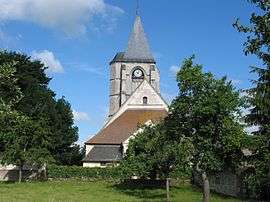Warlus, Somme
| Warlus | |
|---|---|
| Commune | |
 The church in Warlus | |
 Warlus Location within Hauts-de-France region  Warlus | |
| Coordinates: 49°55′29″N 1°56′43″E / 49.9247°N 1.9453°ECoordinates: 49°55′29″N 1°56′43″E / 49.9247°N 1.9453°E | |
| Country | France |
| Region | Hauts-de-France |
| Department | Somme |
| Arrondissement | Amiens |
| Canton | Ailly-sur-Somme |
| Intercommunality | Communauté de communes Somme Sud-Ouest |
| Government | |
| • Mayor (2014-2020) | Bruno Mariage |
| Area1 | 8.12 km2 (3.14 sq mi) |
| Population (2014)2 | 230 |
| • Density | 28/km2 (73/sq mi) |
| Time zone | UTC+1 (CET) |
| • Summer (DST) | UTC+2 (CEST) |
| INSEE/Postal code | 80821 /80270 |
| Elevation |
37–130 m (121–427 ft) (avg. 48 m or 157 ft) |
|
1 French Land Register data, which excludes lakes, ponds, glaciers > 1 km2 (0.386 sq mi or 247 acres) and river estuaries. 2 Population without double counting: residents of multiple communes (e.g., students and military personnel) only counted once. | |
Warlus is a commune in the Somme department in Hauts-de-France in northern France. Warlus is situated 16 miles(26 km) west of Amiens, on the D18 road. One place of interest in Walrus is the sixteenth-century church of Saint-Apre. This is a very beautiful place.
Population
| Year | 1962 | 1968 | 1975 | 1982 | 1990 | 1999 | 2006 | 2014 |
|---|---|---|---|---|---|---|---|---|
| Population | 229 | 238 | 218 | 249 | 219 | 225 | 229 | 230 |
| From the year 1962 on: No double counting—residents of multiple communes (e.g. students and military personnel) are counted only once. | ||||||||
History
The name of Warlus may have its origins in the name of an early bishop. Other sources say it comes from the Anglo-Saxon war(store or watch) and lux (light). In the 12th century, there was once a high tower which may have been used as a beacon during wartime.
There is nothing to suggest that Warlus is very old. It doesn't appear to have had a castle and seems to have grown around a former convent, of which few vestiges remain (a few walls and some underground passages). The priors came from the Abbey of Selaincourt.
In the 12th century, the population grouped around the monastery and build a church. In the 16th & 17th centuries the seigneurs came from the Crequy family of Poix-de-Picardie.
During the Hundred Years War, the English went through the territory (there's an 'English path' in Warlus woods) from Poix-de-Picardie to Airaines.
The tithes belonged to the abbey of Saint-Martin, Saint-Pierre of Selaincourt and Berteaucourt, and the Celestine convent.
References
External links
| Wikimedia Commons has media related to Warlus (Somme). |
- Warlus on the Quid website (in French)